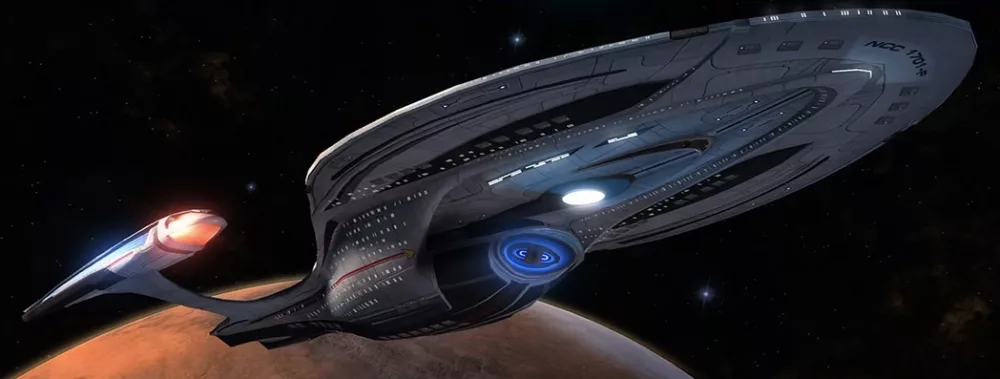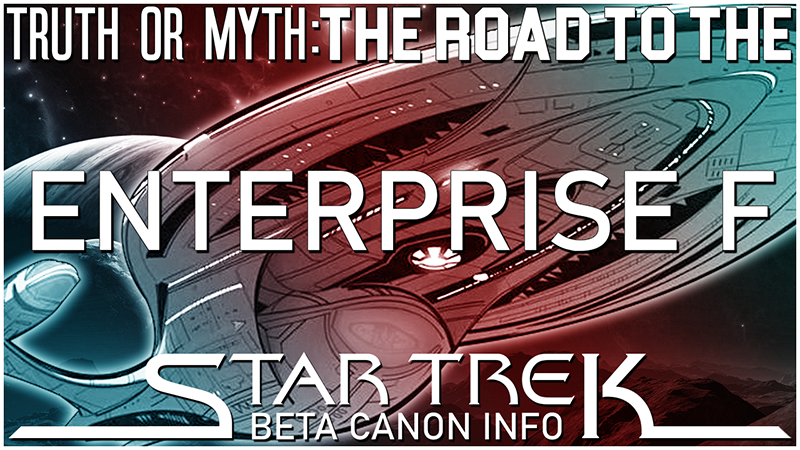In the early 25th century, Starfleet Command began to look once again at the big picture, that of Galactic Exploration. And to usher in this new era, they would decide to commission a brand new starship to lead the way to the future, The USS Enterprise-F, but what was the road that lead up to this fantastic new Enterprise? Well today we find out…
Hello and welcome to another episode of Truth OR Myth Beta Canon, a Star Trek web series that dives in to a the history of any given topic using Beta Canon sources and my own imagination to fill in the gaps. In today’s episode we’re taking a look at the Road to the Enterprise-F, to better understand it’s place in Star Trek History.
Because this IS a Beta Canon video, all information relaid should pretty much be taken with a grain of stardust, and only considered a little bit of Star Trek Fun! And so, with all that out of the way, lets begin.
The journey to the commissioning of the Enterprise-F in 2409, actually began almost 30 years before with Starfleet’s launch of the USS Odyssey and it’s sister ship the USS Verity. Starfleet Command had been impressed with the service of the Sovereign Class as a whole. The Sovereign Class had outperformed every Starfleet starship created to that point in history by leaps and bounds.
After the attack by the Borg Collective at Wolf 359 in 2367, Starfleet had been pushed in to an era of technological development and innovation the likes of which no one had ever seen before. And this development drive would continue on in to the 25th century.
With Starship classes like the Intrepid Class, with a maximum achievable speed of Warp Factor 9.975, Starfleet began to consider a starship class that could be utilized as more of a mobile base, rather then just a starship. And after the launch and successful shakedown of the USS Sovereign, Starfleet gave it’s Starship Design Division the task of making this large dream of theirs a reality.

Many designs would be developed based on the technological developments that had been made since the attack at wolf 359, such as an extremely powerful warp core and bio-neural circuitry, but Starfleet was never sold on any of the designs.
With the return of the USS Voyager in 2378, that would all change. With it’s return, Voyager had brought with it several technologies it had experimented with and encountered while in the Delta Quadrant. Slipstream and A Transwarp Drive were of great interest to Federation Scientists. Though Starfleets Engineers had attempted numerous times to make Transwarp work for Federation Starships, all attempts had failed. But Voyager was not only able to make a Transwarp Drive that worked for them, all be it for a short time, but they were able to present Starfleet Command with an actual Transwarp Coil from a Borg Starship. With this final piece, Starfleet finally believed they had licked the Transwarp Problem and could produce a working, viable Transwarp Drive.
Going over the previously rejected starship class designs with the Transwarp Project leaders, 1 design, named Odyssey, could be easily modified to allow for Transwarp travel. And so that design was chosen. After the required modifications were made for the Transwarp engine system along with some aesthetic changes to make the class appear closer to the design of the Sovereign Class, construction began on 2 prototypes of the class. Sitting at a length of approximately 1,061 meters and a width of approximately 372 meters, the Odyssey Class would be crewed by a standard compliment of 1600 Officers and crew members.
A breakthrough in to Transwarp speeds would be a major defining moment in Starfleet History, but success wasn’t assured. The problem wasn’t really if the Odyssey class could achieve Transwarp, but rather how the new Transwarp drive would powered. There were 2 new Transwarp Cores that were developed. 1 was a modified standard warp core, while the other was a totally new design for the core based on Voyagers encounters with slip stream technology.
The USS Odyssey herself would contain the Modified standard warp core, while the USS Verity would contain the second core based on slipstream technology. The intent was to have both thoroughly tested in a year long shakedown, and this testing would then confirm which core was more efficient and better for the class as a whole.
The Odyssey Class would also have the saucer separation abilities seen in both the Galaxy and Sovereign Classes, along with a new Aquarius Class Escort Vessel which would be docked at the rear of the starship. The reason for this extra vessel included in the design was due to Starfleet’s future plans for the class. A breakthrough in Transwarp technology would mean that almost overnight the entire galaxy would be open to exploration by Starfleet. And with this ability to explore further then any one could have regularly gone before, Starfleet wanted the ability to establish bases and outposts quite quickly.
And so much of the Odyssey design could be easily converted to cargo and colony carrier areas, allowing this class to act as essentially a Starbase facility while the smaller Aquarius Class Vessel would act as a patrol vessel to help defend Starfleets newest areas. To improve the success of this class, it would also include a new comm array developed based on the Midas Array technology also created to communicate with the USS Voyager while she was in the Delta Quadrant. This new comm array system would allow far faster communication with Starfleet Command itself, allowing Starfleet to respond much faster to any potential disasters or attacks. And if the breakthrough to Transwarp could be in fact made, Starfleet would then develop and install various different Transwarp drives in all it’s other classes so this would allow for rescue armadas to be quickly assembled and distributed.
Again, due to this classes mission profile, to be further away exploring and establishing Starfleets presence through out the Galaxy, the main bridge of this class would appear more as a Starbase command center, being much larger and more extensive then any previous Starfleet bridge design. And also included in this bridge design would be another recent breakthrough in Starfleet Technology, that of 3d Starship Consoles. These consoles would display interactive 3d holographic interfaces for it’s crew to control the starship from.
And finally, the last major technological development to be included in this starships design was the Emergency Holographic Crew Replacement System or the EHCR. This technology, based on Voyagers EMH which had made the leap to the ECH would allow an entire holographic crew to assume control over the starship in the event of an emergency. During any situation where an officer at a station was injured or rendered unconscious, the Computer would automatically replace said crewman with a hologram specifically designed to control that station.
Finally in late 2281, both the USS Odyssey and the USS Verity were launched to begin their shakedown cruises. And during initial testing both were able to achieve and maintain Transwarp speeds, though for only a limited time. By the end of the testing phase however, it was clear that the modified warp core contained with in the Odyssey was far more efficient then the one contained in the USS Verity, and so Starfleet recalled the Verity and replaced it’s core with the more standard model.
And although seen a success, Starfleet Command felt further development of the Transwarp drive systems was required before this class was to head in to full production. But before that could happen, the Synth attack on Mars occurred, and as a result of this attack, Starfleet Command suddenly found itself severely lacking a fleet to protect the federation.

In an attempt to save the Romulus and it’s surrounding star systems from destruction from a supernova, Admiral Jean-Luc Picard had convinced Starfleet and the Federation to assist with the Romulan evacuation a plan that would see Utopia Planitia constructing and refitting over 10000 starships. This meant that almost 2/3rd of the Federation Fleet was in dry dock during the attack, and almost all of these starships were lost. As a temporary measure to bolster the fleet, Starfleet would pull all possible starships from its decommission yards, upgrade them quickly with limited defensive technologies, and place them on defense and patrol duties with in the core of the Federation.
While the surviving 1/3rd of the fleet would engage in patrol duties on the Federations Outer borders. While their Allies the Klingon Empire, would would send several task forces to work in tandem with the Federation Fleet along the Romulan Border as the Federation feared reprisal for pulling out of the evacuation mission.
Of course, an attack never happened.
Instead Starfleet began to focus it’s efforts on rebuild its fleet. And to this end, would choose 1 new easily constructed design known as the Inquiry Class, to construct and begin to replace the lost starships.
But by the approach of the 25th Century, the situation in the Alpha and Beta Quadrants had begun to calm down. And with the fleet back at full strength, Starfleet began to look to the future once again, reviving many of the older designs from 2370s, and revamping them with current technology to usher in the new century. The Odyssey Class was a high priority for Starfleets new Exploratory Missions of the 25th century. Both the Odyssey and the Verity had been out in Romulan Space during the Synth Attack, and in the past 2 decades had proved themselves to be a value to Starfleet, even though they were already 20 years old.
So Starfleet Command had one of it’s design teams focus in on the Odyssey Class and redesign it internally from the ground up to take advantage of all the newly developed technologies of previous two decades. After the new plans were approved, both the Odyssey and Verity were recalled to Space Dock for immediate refit, and once complete, both would be sent out on a one year shakedown to test out all the new systems, and both performed beautifully. And by 2405, Starfleet Command had decided to construct 12 additional Odyssey Class starships. And with the final mission of the Enterprise-E, Starfleet Command would make one last decision that would cement the class in Starfleet History, that of naming the 3rd Vessel off the line, that of the Enterprise-F.
In 2409, the USS Enterprise F, the Seventh Starship to bear the name, would be launched to great pomp and circumstance.
It’s mission? To explore strange new worlds, to seek out new life and new civilizations, to boldly go, where no one had gone before…
Watch The Latest Truth Or Myth Below
Thank you for watching today’s episode of Truth or Myth, what do you think of the Odyssey Class, it’s history and the Enterprise F? Do you want to see this starship in Star Trek Picard? Well leave your comments in the section below and don’t forget to like the video and subscribe to the channel, hitting that little bell icon so you wont miss a single video we release.
What to help this channel reach Transwarp Velocities? Then consider becoming a channel Patron, the link to our Patreon Account is in the description below. Thanks again for watching, Live long and prosper…












